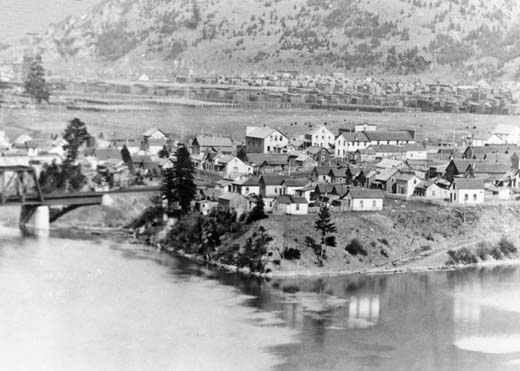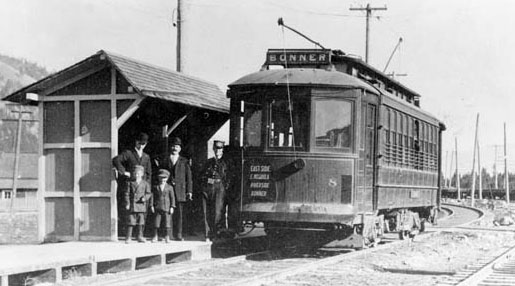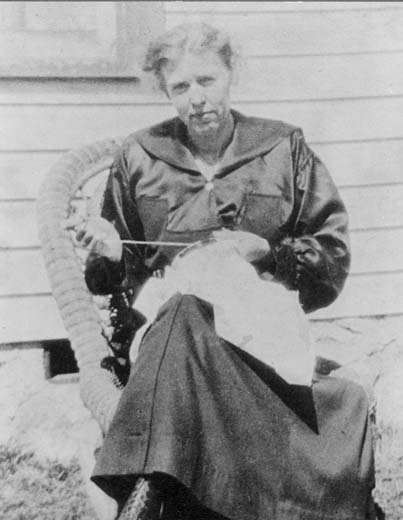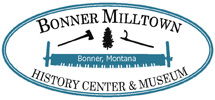Milltown
 Milltown circa 1915 While residents of Bonner and Milltown were attracted to the area principally because of the economic opportunities offered by the mill, the settlements have very different origins. Bonner, the company town, was laid out and constructed by the mill management for the mill managers and supervisors.
Milltown circa 1915 While residents of Bonner and Milltown were attracted to the area principally because of the economic opportunities offered by the mill, the settlements have very different origins. Bonner, the company town, was laid out and constructed by the mill management for the mill managers and supervisors.
The land where the Riverside (later renamed Milltown) settlement sprang up is on a hill overlooking the confluence of the Clark Fork and Big Blackfoot rivers and about ½ mile south of the mill. Originally owned as farmland, John McCormick leased small parcels to workers. It was said that the mill workers built their homes by “moonlight” as the company did not seem to mind if inventory was diverted to building the small homes.
As the population grew, businesses sprang up to serve their needs. Longtime resident Mildred Dufresne reported that by 1892 there were already a dozen homes, a livery stable, a boarding-rooming house and three saloons.
In 1903, Riverside boomed. John McCormick sold his land to the Western Lumber Company owned by W.A. Clark. Part of the land and the newly purchased Ray farm would become the reservoir behind a proposed hydroelectric dam. More lots 35x130 feet were created and leased in the increasing worker population. It wasn’t until decades later that homeowners were able to purchase the land their homes are on.
The construction of the Milltown Dam beginning in 1905 and the arrival of the Western Lumber Company in 1910 brought more immigrants and most of the population of Riverside were of definite ethnic groups: Finns, the most numerous; Norwegians and Swedes; and French Canadians. In 1928 when the Anaconda Copper Mining Company purchased the Western Lumber Company, most workers stayed on to work for ACM.
Milltown has always been influenced by roads and railroad lines. Prior to 1908 when the reservoir was flooded, the Mullan Road was the main road with a ford at the mouth of the Blackfoot. Most of the businesses were located in the south side of town. By 1908 a new bridge was built across the Blackfoot at the site of the current pedestrian Black Bridge and businesses shifted their location to take advantage of the traffic. This road was used until 1948 when the present Highway 200 was constructed. In addition, the Northern Pacific ran through town east and west and for a time passengers and freight services were offered at the Milltown Station. Car 51 at the Milltown Stop The streetcar, powered by Clark’s dam, provided the main transportation between Bonner and Riverside to Missoula from 1910 to 1932. By then the first local stop was in Milltown; the name had been changed to Milltown in 1913 when it was learned that another post office already had the name of Riverside.
Car 51 at the Milltown Stop The streetcar, powered by Clark’s dam, provided the main transportation between Bonner and Riverside to Missoula from 1910 to 1932. By then the first local stop was in Milltown; the name had been changed to Milltown in 1913 when it was learned that another post office already had the name of Riverside.
Piltzville
 Mrs. Piltz Piltzville is the “banana belt” of the Bonner area. Nestled along the south base of Bonner Mountain, the homes are protected from the chilling Blackfoot winds.
Mrs. Piltz Piltzville is the “banana belt” of the Bonner area. Nestled along the south base of Bonner Mountain, the homes are protected from the chilling Blackfoot winds.
The Piltzville neighborhood is named for Billy Piltz who came from Maine to work at the lumber mill in Bonner where he eventually became yard boss. The Piltz house was built in 1904, the third house in the neighborhood. On the west side of the first floor of the Piltz residence was a small store operated by Mrs. Piltz.
During World War I, timber on the land just west of Piltzville was cleared and crops were grown on behalf of the war effort. The gardens in the “dry farm” were not too successful since there was no running water in the area and water had to be carried by hand to the gardens.
Most residents of Piltzville worked at the mill. Living in Piltzville gave them the opportunity to own land and their own homes.
In 1971 area residents formed a volunteer fire fighting association which became part of the Missoula Rural Fire District. The fire station was located in the old Fleming restaurant building in Piltzville which has been expanded and modernized.
Today Piltzville remains a residential area, home to many long-time residents.
Bonner
 Early Bonner For more than 120 years, Bonner quietly fulfilled the only role it ever had: company town. When the mill was established in 1886, Bonner was so isolated that the company built residences for the workers and their families. Until their homes could be completed, families sometimes lived in tents or stayed with others already occupying homes.
Early Bonner For more than 120 years, Bonner quietly fulfilled the only role it ever had: company town. When the mill was established in 1886, Bonner was so isolated that the company built residences for the workers and their families. Until their homes could be completed, families sometimes lived in tents or stayed with others already occupying homes.
Families were part of the fabric of Bonner from the earliest days. The Weekly Missoulian, April 8, 1887, records the birth of a daughter to Mr. and Mrs. Charles Rouleau of Bonner, Montana Territory.
By 1888 the first post office was established, followed in 1889 by the completion of Bonner Hall, which housed the Masonic Lodge. The Bonner School first held classes there in August and continued until a new building was built closer to Piltzville and Milltown in 1907. After the school moved, Bonner Hall continued as the social center and later served as office for the Blackfoot Forest Protective Association until torn down in the early 1940s.
In 1892 the grand Margaret Hotel was constructed to house dignitaries making the long trip from Missoula and farther destinations. It featured beautifully appointed rooms and fine dining. Over the years it at times housed the post office and library and was home to single mill workers as well as families. Its demolition in 1957 is lamented to this day. The Margaret Hotel was the showcase of Bonner. The arrival of Kenneth Ross as mill manager in 1899 perhaps played a pivotal role in the shaping of Bonner’s society. An experienced mill manager, Ross was also skilled at human relations and under his 26 year administration, Bonner flourished. He made sure his workers were well treated: the company made no profit on house rentals or at the company store, established in the late 1880s. He provided a public library at the urging of County Librarian, Mrs. Ruth Worden, and agreed to let Charles Hart establish the community or “Victory Gardens” in 1918 that were worked and appreciated by gardeners until the late 1940s when the mill expanded.
The Margaret Hotel was the showcase of Bonner. The arrival of Kenneth Ross as mill manager in 1899 perhaps played a pivotal role in the shaping of Bonner’s society. An experienced mill manager, Ross was also skilled at human relations and under his 26 year administration, Bonner flourished. He made sure his workers were well treated: the company made no profit on house rentals or at the company store, established in the late 1880s. He provided a public library at the urging of County Librarian, Mrs. Ruth Worden, and agreed to let Charles Hart establish the community or “Victory Gardens” in 1918 that were worked and appreciated by gardeners until the late 1940s when the mill expanded.
Land for the Bonner School as well as two community churches, St. Ann Catholic Church and Our Savior’s Lutheran Church were provided by the mill in the early 1900s. Though the structures have changed, those three community pillars still stand side by side today.
Kenneth Ross’ successors continued his style through the years and Bonner suffered less from labor unrest than did other ACM properties. Bonner School, St. Ann Catholic Church, Our Savior's Lutheran Church In 1972 Champion International Corporation acquired most of the assets of Anaconda Forest Products and on October 2 of that year U.S. Plywood started sawmill operations. Mill properties, including the Bonner houses, changed hands through the years until Stimson Lumber Company sold the houses to Scott Cooney's Montana Improvement Company in fall of 2007. Stimson subsequently ceased mill operations and put the property up for sale in 2009.
Bonner School, St. Ann Catholic Church, Our Savior's Lutheran Church In 1972 Champion International Corporation acquired most of the assets of Anaconda Forest Products and on October 2 of that year U.S. Plywood started sawmill operations. Mill properties, including the Bonner houses, changed hands through the years until Stimson Lumber Company sold the houses to Scott Cooney's Montana Improvement Company in fall of 2007. Stimson subsequently ceased mill operations and put the property up for sale in 2009.
By the time the houses were sold in 2007, modern life long ago erased the isolation that had fostered creation of the society of Bonner. The sale created another irrevocable change: company houses were exactly that. Only active mill managers lived there; there were no widows or retirees. From now on renters and eventual owners of the restored houses will live there through choice, not employment.
Lengthy legal procedures resulted in the Montana Improvement Company declaring bankruptcy in 2011. Some of the Bonner houses were restored by then, but the fate of others was in doubt.
Having survived and flourished much longer than most company towns, Bonner begins a new chapter. Local history advocates are working to see that its heritage will forever be noted on the National Register of Historic Places as the Bonner Company Town Historic District.
The Immigrants
The prospect of work and a wide open country initially drew people to Bonner-Milltown. Many others immigrated from Canada’s Quebec, New Brunswick, and Nova Scotia provinces, as well as Northern Maine. Many others came from Scandinavia, especially Finland, via Michigan and Wisconsin. They moved here because jobs in the mines and forests of the East and Midwest had dwindled or because working conditions there were intolerable.
In 1941, when the population of Milltown was less than 1,000, there were approximately 12 percent Finns, 15 percent, French Canadians, 20 percent, Swedes, 30 percent, Norwegians, and 23 percent native-born and undetermined. George Petaja, the first child born in Milltown, once recalled at least 20 different nationalities in the 1920s.
Finns
Conditions in Finland caused huge immigrations to the US between 1890 and 1910 as many farmers were forced off their land. Finnish immigrants came straight from Finland to Bonner in considerable numbers, assured by relatives and friends that they could get work at the mill.
Because of the large Finnish population in the area, Riverside [Milltown] was first dubbed “Finn Town,” a name later given to Milltown Flat, or West Riverside, after Finn Hall was moved there.
Finns who came early worked at the Bonner Mill or building the railroads. Some lived in cabins along the Blackfoot, but floods made them happy to take advantage of John McCormick’s leased lots in Riverside in the late 1800s. They built homes with lumber from the mill, sometimes obtained by “midnight requisition,” apparently tolerated by the Company which was glad to have steady workers. Single men stayed in boarding houses; there was at least one in Riverside in 1892. They often worked in the logging camps in the winter, when the mill was closed. By 1913, there were 570 Finns living in Milltown, about 2/3 of its population.
Finnish families came as well. Concerned that the drinking and fighting of some single men gave a bad reputation to Finns in general, some families in 1895 formed a local chapter of the Finnish National Brothers Temperance Union, an organization with a distinct religious orientation. Within a few years it was taken over by a more left-leaning group of Finnish immigrants, and by 1904 the Temperance Society was dissolved, and their original hall was sold.
By 1906 a large number of men and women had joined the Socialist Federation, and a larger number, remaining non-members, had accepted the Socialist philosophy at least partially and were willing to follow its leadership. In 1907, the more Socialist-leaning Finns built a new hall that had a stage and bench-seating for 150 people. It was originally located near the current Bonner/I-90 exit, but in 1912 Clark offered to purchase a lot and move the building, to make room for his new mill. The building was moved to its present location in West Riverside at the corner of Riverside and 4th Street in 1913.
There was great activity in Finn Hall, or the Sunomi Club as it was called, from 1913-18. Dances were held regularly on Wednesday and Saturday nights. A men’s athletic club was very active and a drama club utilized the stage located at one end of the building. After WWI there was less activity in the Hall, and except for activity in 1939-40 when Russia and Finland were at war, the use of the hall died out. The building was sold in the 1950s, and it is currently used for commercial storage. Long recognized for its white paint, the building is now brown.
When representatives (all Finns) of the Butte miners already on strike came to Bonner to find support in 1908, Finns in Bonner gave a very receptive ear to the issues of low wages and poor working conditions. Workers of nationalities were represented in the walk out, but Finns were prominently in the leadership and comprised nearly two-thirds of the strikers. Many residents remembered the Finnish women who jeered the non-strikers on their way to work. In the end, the strike was unsuccessful; the mill hired a new group of immigrants. However, Finns continued to be the dominant immigrant group in Milltown.
Labor strikes--brought about through the efforts of the Industrial Workers of the World (IWW)--broke out in 1917, led by Finns, again for better wages and the eight-hour work day. Like before, the strike was unsuccessful, and many lost their jobs. There was a second major exodus of Finns from Milltown but this time there were fewer immigrants who followed to take their place and the number of Finns declined.
Swedes also came to Bonner, drawn more by the railroads, though some certainly worked at the mill. Many came via Minnesota and the lumber industry there. For a time they established a small mission church on the east side of the Blackfoot River. Later it became part of Our Saviors Lutheran Church, one of the two churches in Bonner today.
Norwegians initially were a small percentage of the population (About 20 in 1906) but by the 1940s had increased substantially. The church, Our Savior’s Lutheran Church, was built in 1910 on land donated by the Anaconda Company. The Lutheran Church was a definite contributing element to attracting a Norwegian settlement to Bonner.
French Canadians were among the earliest immigrants; they came first for the railroads and then the lumber mills and logging camps. Andrew B. Hammond came from New Brunswick and recruited many of his fellow Canadians to work at the mill. Most of the Canadians settled first in Frenchtown, west of Missoula, where there was an established Catholic church. Later a mission church was established at Bonner and ultimately it split off on its own as the St. Ann’s Catholic Church, the second church in Bonner.
Japanese, Irish, and Italian immigrants were more associated with railroad construction--the Northern Pacific in the 1880s and the Milwaukee in 1908. Their effect on Milltown’s settlement was only temporary; they did not stay.
Communities
 The confluence of the Clark Fork and Blackfoot Rivers is bordered by the several communities. Closest to the confluence itself is Milltown; north of the Clark Fork and west of the Blackfoot lie West Riverside and Pine Grove; north of the Clark Fork and east of the Blackfoot is Bonner and Piltzville.
The confluence of the Clark Fork and Blackfoot Rivers is bordered by the several communities. Closest to the confluence itself is Milltown; north of the Clark Fork and west of the Blackfoot lie West Riverside and Pine Grove; north of the Clark Fork and east of the Blackfoot is Bonner and Piltzville.
For thousands of years the rivers now known as the Big Blackfoot and Clark Fork flowed to the sea without human intervention save for occasional visits by native tribes and early explorers.
In the mid-1800s that changed. In 1864 Montana became a territory and Missoula Mills, now known as just Missoula, was founded.
Entrepreneurs recognized the great merchandizing potential of the area, established partnerships, and located in the new town of Missoula. Those interests soon expanded to include lumbering ventures to meet the demands of the railroad and the mines in Butte.
Names such as Hammond and Bonner, two of the partners in the Montana Improvement Company, became forever linked to the history of the area when, in June, 1886, the first logs were sawed at new, permanent mill.
The land on which the mill and town of Bonner was built was allegedly purchased from settler Hiram Farr for $100 and a cow. Gladys Peterson in A Grass Roots Tribute: The Story of Bonner, Montana, (1976) wrote that “Bonner, Montana can make no claim for remarkable size or remarkable growth. After 90 years of existence it possesses only 45 houses and a population of about 150 persons. Yet this town which has no mayor, no town hall, nor any apparent local government continues to function in the role it was assigned at its birth, the role of a company town.”
The company town was built in part to have supervisors near the mill 24/7. Mill workers and loggers including French Canadians, Finns, Swedes, and Norwegians had to settle nearby. Riverside, now Milltown, a part of John McCormick’s ranch, was neatly divided into lots leased to immigrant workers.
By 1910, land ownership became an option when Barbara Zaugg subdivided West Riverside across the Blackfoot from Riverside (Milltown). The establishing of the Western Lumber Company on the Clark Fork River increased West Riverside’s population.
Piltzville, to the east, and Pine Grove, to the west, offered farming opportunities as well as more opportunities for land ownership for mill workers.
The School and Churches
127 a d churches school
Old Bonner School and Churches
The Bonner School and Catholic and Lutheran Churches have had a long presence in the Bonner-Milltown area.
Communities
Communities at Play
Sleigh Riding in Bonner, Montana
Glen Max Smith, aka "The Hooligan," recalls sledding adventures on Bonner Mountain using Flexible Flyers, skis, boxes, and Coca Cola signs.
